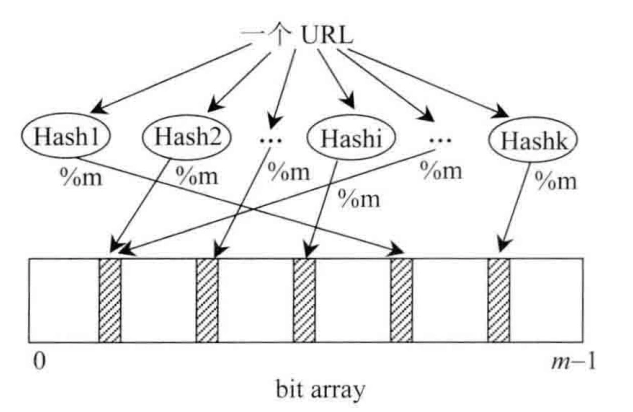关于BloomFilter
先要了解什么是hash函数。
哈希函数
布隆过滤器离不开哈希函数,所以在这里有必要介绍下哈希函数的概念,如果你已经掌握了,可以直接跳到下一小节。
哈希函数的性质:
- 经典的哈希函数都有无限大的输入值域(无穷大)。
- 经典的哈希函数的输出域都是固定的范围(有穷大,假设输出域为S)
- 当给哈希函数传入相同的值时,返回值必一样
- 当给哈希函数传入不同的输入值时,返回值可能一样,也可能不一样。
- 输入值会尽可能均匀的分布在S上
前三点都是哈希函数的基础,第四点描述了哈希函数存在哈希碰撞的现象,因为输入域无限大,输出域有穷大,这是必然的,输入域中会有不同的值对应到输入域S中。第五点事评价一个哈希函数优劣的关键,哈希函数越优秀,分布就越均匀且与输入值出现的规律无关。比如存在"hash1","hash2","hash3"三个输入值比较类似,经过哈希函数计算后的结果应该相差非常大,可以通过常见的MD5和SHA1算法来验证这些特性。如果一个优秀的函数能够做到不同的输入值所得到的返回值可以均匀的分布在S中,将其返回值对m取余(%m),得到的返回值可以认为也会均匀的分布在0~m-1位置上。
接下来开始介绍布隆过滤器。
有一个长度为m的bit型数组,如我们所知,每个位置只占一个bit,每个位置只有0和1两种状态。假设一共有k个哈希函数相互独立,输入域都为s且都大于等于m,那么对同一个输入对象(可以想象为缓存中的一个key),经过k个哈希函数计算出来的结果也都是独立的。对算出来的每一个结果都对m取余,然后在bit数组上把相应的位置设置为1(描黑),如下图所示:

至此一个输入对象对bit array集合的影响过程就结束了,我们可以看到会有多个位置被描黑,也就是设置为1.接下来所有的输入对象都按照这种方式去描黑数组,最终一个布隆过滤器就生成了,它代表了所有输入对象组成的集合。
那么如何判断一个对象是否在过滤器中呢?假设一个输入对象为hash1,我们需要通过看k个哈希函数算出k个值,然后把k个值取余(%m),就得到了k个[0,m-1]的值。然后我们判断bit array上这k个值是否都为黑,如果有一个不为黑,那么肯定hash1肯定不在这个集合里。如果都为黑,则说明hash1在集合里,但有可能误判。因为当输入对象过多,而集合过小,会导致集合中大多位置都会被描黑,那么在检查hash1时,有可能hash1对应的k个位置正好被描黑了,然后错误的认为hash1存在集合里。
控制布隆过滤器的误判率
如果bit array集合的大小m相比于输入对象的个数过小,失误率就会变高。这里直接引入一个已经得到证明的公式,根据输入对象数量n和我们想要达到的误判率为p计算出布隆过滤器的大小m和哈希函数的个数k.
布隆过滤器的大小m公式:

哈希函数的个数k公式:

布隆过滤器真实失误率p公式:

例子1:假设我们的缓存系统,key为userId,value为user。如果我们有10亿个用户,规定失误率不能超过0.01%,通过计算器计算可得m=19.17n,向上取整为20n,也就是需要200亿个bit,换算之后所需内存大小就是2.3G。通过第二个公式可计算出所需哈希函数k=14.因为在计算m的时候用了向上取整,所以真是的误判率绝对小于等于0.01%。
例子2:n=100亿,p=0.0001(万分之一),m=131,571,428,572bit=131,571,428,572/8字节=22.3G,22.3G为实际空间,
Hash函数的个数K,,可得K= 0.7*m/n,可约得13个,那么真实失误率p=6/十万。
综上:m的长度与失误率p有关,m越大,失误率p越小。
快速集成BloomFilter
关于布隆过滤器,我们不需要自己实现,谷歌已经帮我们实现好了。
- 引入依赖
<!-- https://mvnrepository.com/artifact/com.google.guava/guava --> <dependency> <groupId>com.google.guava</groupId> <artifactId>guava</artifactId> <version>25.1-jre</version> </dependency>
- 核心API
1 /** 2 * Creates a {@link BloomFilter BloomFilter<T>} with the expected number of 3 * insertions and expected false positive probability. 4 * 5 * <p>Note that overflowing a {@code BloomFilter} with significantly more elements 6 * than specified, will result in its saturation, and a sharp deterioration of its 7 * false positive probability. 8 * 9 * <p>The constructed {@code BloomFilter<T>} will be serializable if the provided 10 * {@code Funnel<T>} is. 11 * 12 * <p>It is recommended that the funnel be implemented as a Java enum. This has the 13 * benefit of ensuring proper serialization and deserialization, which is important 14 * since {@link #equals} also relies on object identity of funnels. 15 * 16 * @param funnel the funnel of T's that the constructed {@code BloomFilter<T>} will use 17 * @param expectedInsertions the number of expected insertions to the constructed 18 * {@code BloomFilter<T>}; must be positive 19 * @param fpp the desired false positive probability (must be positive and less than 1.0) 20 * @return a {@code BloomFilter} 21 */ 22 public static <T> BloomFilter<T> create( 23 Funnel<T> funnel, int expectedInsertions /* n */, double fpp) { 24 checkNotNull(funnel); 25 checkArgument(expectedInsertions >= 0, "Expected insertions (%s) must be >= 0", 26 expectedInsertions); 27 checkArgument(fpp > 0.0, "False positive probability (%s) must be > 0.0", fpp); 28 checkArgument(fpp < 1.0, "False positive probability (%s) must be < 1.0", fpp); 29 if (expectedInsertions == 0) { 30 expectedInsertions = 1; 31 } 32 /* 33 * TODO(user): Put a warning in the javadoc about tiny fpp values, 34 * since the resulting size is proportional to -log(p), but there is not 35 * much of a point after all, e.g. optimalM(1000, 0.0000000000000001) = 76680 36 * which is less than 10kb. Who cares! 37 */ 38 long numBits = optimalNumOfBits(expectedInsertions, fpp); 39 int numHashFunctions = optimalNumOfHashFunctions(expectedInsertions, numBits); 40 try { 41 return new BloomFilter<T>(new BitArray(numBits), numHashFunctions, funnel, 42 BloomFilterStrategies.MURMUR128_MITZ_32); 43 } catch (IllegalArgumentException e) { 44 throw new IllegalArgumentException("Could not create BloomFilter of " + numBits + " bits", e); 45 } 46 }
1 /** 2 * Returns {@code true} if the element <i>might</i> have been put in this Bloom filter, 3 * {@code false} if this is <i>definitely</i> not the case. 4 */ 5 public boolean mightContain(T object) { 6 return strategy.mightContain(object, funnel, numHashFunctions, bits); 7 }
- 例子
1 public static void main(String... args){ 2 /** 3 * 创建一个插入对象为一亿,误报率为0.01%的布隆过滤器 4 */ 5 BloomFilter<CharSequence> bloomFilter = BloomFilter.create(Funnels.stringFunnel(Charset.forName("utf-8")), 100000000, 0.0001); 6 bloomFilter.put("121"); 7 bloomFilter.put("122"); 8 bloomFilter.put("123"); 9 System.out.println(bloomFilter.mightContain("121")); 10 }
Over...
参考: